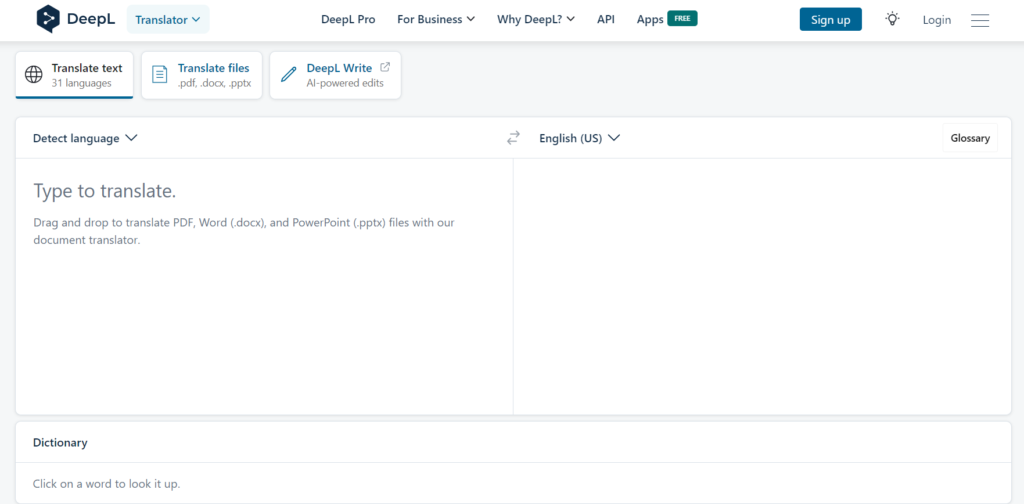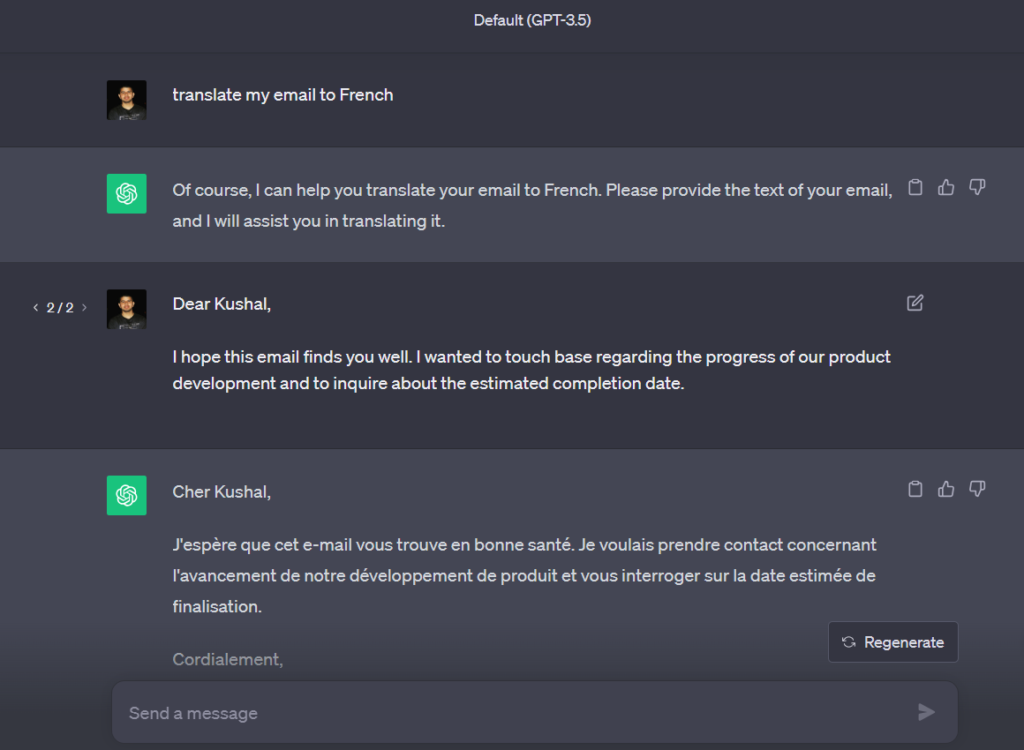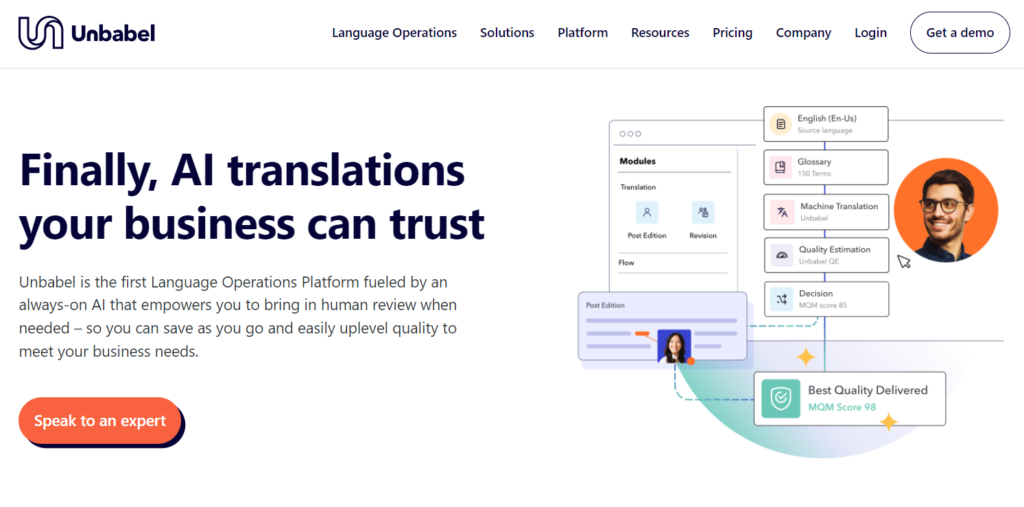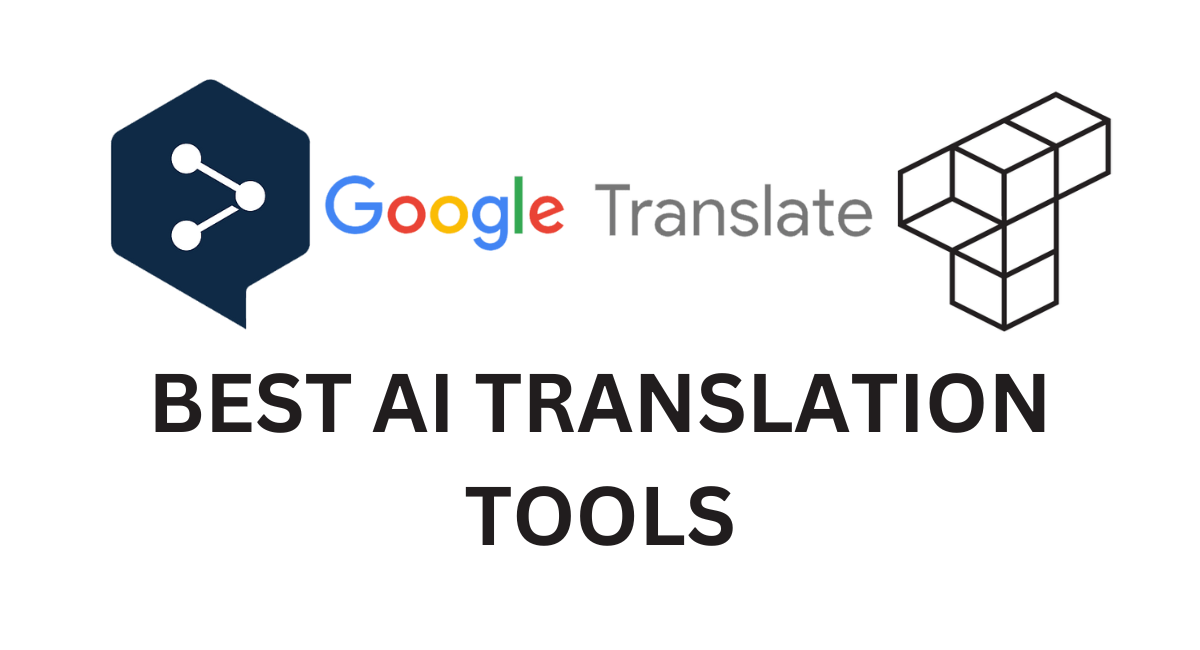Welcome to the world of AI translation, where cutting-edge technology is revolutionizing the way we bridge linguistic divides. In our increasingly interconnected world, where diverse languages coexist, translation services have never been more vital.
We live in an era where communication knows no borders, and the demand for effective translation is soaring.
Best AI Translation Tools (Snapshot)
| Tool | Key Features | Pricing |
|---|---|---|
| Google Translate | – Large Language Models – Multilingual Support – Web and Mobile Platforms – Real-Time Translation – Voice Translation – Additional Features (Spell Checking, Transcription, Contextual Translations, etc.) – Online and Offline Usage | Free |
| DeepL | – Translation Versatility – High Translation Accuracy – Support for Large Documents – Handling Idiomatic Expressions – Seamless Integration | Free Version and Pro Version starting at $8.74 per month (billed annually) |
| Bing Microsoft Translator | – Text and Speech Translation – Collaborative Translation – Microsoft Ecosystem Integration – APIs for Developers – Real-Time Conversation Translation | Free |
| Taia | – Broad Language Coverage – Human-AI Hybrid Approach – Instant Rate Estimates – High Client Satisfaction – Long-Term Project Support | Variable Pricing Based on Project Needs |
| Amazon Translate | – Extensive Language Support – Language Identification – Real-Time and Batch Translations – Cost-Effective Pricing | Free Tier and Paid Plans starting at $15 per million characters |
| ChatGPT | – Conversational AI – Contextual Understanding – Integration Capabilities | Freemium model with Premium Subscriptions starting at $20 per month |
| Systran | – Preservation of Document Layout – Custom Glossaries and Translation Memories – Advanced User Dictionaries – Real-Time Translation Tool | Variable Pricing Based on Customization |
| Smartling | – Translation in Over 150 Languages – Translation Memory and Terminology Management – Workflow Automation – Customizable Translation Workflows – Dedicated Customer Success Managers | Pricing Available on Request |
| Unbabel | – Three-Phase Translation Process – Multilingual Support – Customizable Workflows – Dedicated Customer Success Managers | Pricing Available on Request (Minimum Commitment: $10,000) |
Table of Contents
What is AI Translation?
At the core of this revolution lies AI translation. But what precisely is AI translation? In simple terms, it encompasses the utilization of machine learning and natural language processing (NLP) techniques to automatically render text from one language into another, all while preserving the original content’s meaning, context, and tone.
The objective is to eliminate language barriers, facilitating effortless communication among people from various parts of the world.
Picture this scenario: you possess a text in one language, and your intention is for it to be comprehensible to someone conversing in a different language.
AI translation emerges as the bridge for linguistic understanding, ensuring that the message maintains its integrity during its voyage from one language to another.
How Does AI Translation Work?
AI translation employs a variety of technologies, including machine translation, neural networks, and Generative AI, to achieve its remarkable feats. Let’s take a closer look at how these components work together:
- Machine Translation (MT): Machine translation relies on linguistic rules and statistical models to convert text from one language into another. While it’s proficient at providing a basic understanding of text, it often struggles with idiomatic expressions, nuanced language, and context. Think of it as a good starting point for translation.
- Neural Networks: Enter neural networks, the backbone of AI translation. These networks, inspired by the human brain, process vast amounts of data to understand language intricacies. They learn from feedback and gradually improve their translation capabilities over time. Neural networks are like language detectives, uncovering the subtleties and complexities of language.
- Generative AI (GenAI) Translation: A subset of AI translation, Generative AI (GenAI) goes beyond merely translating input into output. It can create entirely new and unique translations by learning from sequences of sentences. GenAI translation, exemplified by tools like ChatGPT, excels at recognizing context and generating translations that accurately reflect the original content’s tone and meaning.
Benefits of AI Translation
AI translation brings a multitude of benefits to the table, making it an indispensable tool in our globalized world:
- Scalability: As businesses expand and engage with a broader array of languages, AI translation tools easily adapt to meet these growing demands. This scalability ensures that businesses can consistently deliver accurate translations, regardless of project size or complexity.
- Breaking Language Barriers: AI translation tools excel at real-time translation, allowing for effective communication with people from diverse language backgrounds. This leads to improved relationships, heightened customer satisfaction, and an expanded global reach.
- Cost-Effective Solution: AI translations offer an efficient and cost-effective alternative to hiring professional human translators. These tools save both time and money, without sacrificing translation quality.
Top AI Translation Tools
1. Google Translate

Google Translate is a leading AI translation tool renowned for its wide range of features, accessibility, and reliability. It combines various language models and techniques to enhance translation accuracy and fluency. Let’s explore its key attributes in detail.
Google Translate leverages Large Language Models (LLMs) trained on extensive datasets of text and code. These models enable Google Translate to grasp the intricate patterns of human language, resulting in more natural-sounding and accurate translations.
Key Features of Google Translate:
- Large Language Models: Google Translate utilizes multiple LLMs, ensuring higher translation accuracy and fluency.
- Multilingual Support: This tool offers translation services for a wide array of languages, making it versatile for global communication.
- Web and Mobile Platforms: Users can access Google Translate through web-based and mobile app platforms, providing convenience and accessibility.
- Real-Time Translation: The mobile app incorporates real-time translation features, enabling users to translate text using their device’s camera.
- Voice Translation: Google Translate supports voice translation, making it valuable for spoken language conversion.
- Additional Features: Beyond standard text translation, Google Translate offers extra functionalities, such as spell checking, transcription, and contextual translations. It also includes automatic language detection, conversation mode for mobile, and an integrated dictionary.
Google Translate Pricing :
Google Translate is a free
Pros and Cons of Google Translate:
| Pros of Google Translate | Cons of Google Translate |
|---|---|
| ✅ High Accuracy | ❌ Manual Input |
| ✅ User-Friendly | ❌ Limited Integrations |
| ✅ Swift Translations | ❌ No Generative AI |
| ✅ Free of Charge | |
| ✅ Verified Translations |
2. DeepL

DeepL is a powerful AI translation tool renowned for its outstanding translation quality. It utilizes neural networks to produce highly accurate and contextually appropriate translations, primarily focusing on major global languages.
This tool stands out for its precision in capturing the nuances of the original text, making translations feel more natural and fluent.
Key Features of DeepL:
- Translation Versatility: DeepL offers translation services between 31 languages, allowing users to communicate across diverse linguistic boundaries with ease.
- High Translation Accuracy: One of DeepL’s standout features is its ability to provide high-accuracy translations. It excels in understanding and reproducing the context and tone of the original content.
- Integration Capabilities: DeepL seamlessly integrates with web browsers and popular applications, making it a versatile tool that can be used across various platforms.
- Support for Large Documents: Users can rely on DeepL for translating lengthy documents without compromising the original meaning.
- Handling Idiomatic Expressions: DeepL is proficient in translating idiomatic expressions, preserving the original idioms’ meaning and cultural relevance.
DeepL Pricing:
DeepL offers a range of pricing options to suit different user needs, starting at $8.74 per month (billed annually). It also provides a free version with basic features and a Pro version that enhances translation quality and customization options.
Pros and Cons of DeepL:
| Pros of DeepL | Cons of DeepL |
|---|---|
| ✅ Exceptional translation quality | ❌ No integrations with other tools |
| ✅ Easy-to-use and seamless integration into Windows and iOS | ❌ Limited options for uploading style guides or brand voice |
| ✅ Option to customize translations and maintain control | ❌ Manual process of copying and pasting text for translation |
| ✅ Retains formatting of the original document | ❌ Limited glossaries on the free plan |
| ✅ Provides an API, Chrome plugins, and a free plan | ❌ Limited translation memory |
3. Bing Microsoft Translator

Bing Microsoft Translator is a widely recognized AI translation tool that offers a comprehensive set of language translation services.
It encompasses text translation, speech translation, and even real-time conversation translation, all supported by robust AI detector technology.
A key advantage of Bing Microsoft Translator is its seamless integration with various Microsoft products, making it a preferred choice for users within the Microsoft ecosystem.
Key Features of Bing Microsoft Translator:
- Text and Speech Translation: Bing Microsoft Translator excels in both text and speech translation, enabling users to translate written content and spoken language effortlessly.
- Collaborative Translation: Users can leverage collaborative translation features, such as translation history and phrasebook creation, to save and organize translations and collaborate with others on multilingual projects.
- Microsoft Ecosystem Integration: This tool is seamlessly integrated with Microsoft products like Word and PowerPoint, enhancing convenience for users working with these applications.
- APIs for Developers: Bing Microsoft Translator offers APIs that developers can integrate into their applications, making it a versatile tool for various software development projects.
- Real-Time Conversation Translation: The mobile app of Bing Microsoft Translator supports real-time conversation translation, facilitating smooth communication between individuals who speak different languages.
Bing Microsoft Translator Pricing:
Bing Microsoft Translator is available as a free tool, ensuring accessibility to a wide range of users.
Pros and Cons of Bing Microsoft Translator:
| Pros of Bing Microsoft Translator | Cons of Bing Microsoft Translator |
|---|---|
| ✅ Microsoft Integration: Seamlessly integrates with Microsoft products for user convenience. | ❌ Accuracy Limits: May struggle with idiomatic expressions. |
| ✅ Text and Speech Translation: Versatile tool for text and speech translation. | ❌ Limited Dialects: Offers a limited range of dialects. |
| ✅ Collaboration Features: Facilitates team collaboration with history and phrasebook. | ❌ No Third-Party Integration: Lacks integration with external tools. |
| ✅ Microsoft Ecosystem: Enhances workflow efficiency within Microsoft. | ❌ Manual Input: Requires manual text copy-pasting. |
| ✅ Developer APIs: Offers APIs for integration and customization. | ❌ Limited Translation Storage: Minimal options for storing translations. |
4. Taia

Taia is a versatile AI translation tool renowned for its capacity to provide accurate translations across 97 different languages.
This platform seamlessly combines the power of AI technology with the finesse of human translators, offering reliable translation services to a wide user base.
It streamlines the translation process, promising quick results with a 99.4% client satisfaction rate.
Key Features of Taia:
- Broad Language Coverage: Taia supports translations in 97 languages, ensuring the ability to reach diverse global audiences.
- Human-AI Hybrid Approach: Taia’s translation process blends the expertise of human translators with the efficiency of AI technology, striving for accurate and efficient results.
- Instant Rate Estimates: Users receive instant rate estimates for their translation projects, promoting cost transparency and budget control.
- Client Satisfaction: Taia boasts a high client satisfaction rate of 99.4%, reflecting its commitment to quality translation services.
- Long-Term Project Support: For users with ongoing translation needs, Taia provides support for long-term projects.
Taia Pricing:
Taia’s pricing structure is variable and depends on factors such as project size, the type of translation service, language pairs, service level, and project deadlines. Costs per translation generally decrease as more translations are performed.
Pros and Cons of Taia:
| Pros of Taia | Cons of Taia |
|---|---|
| ✅ Language Variety: Taia supports 97 languages, ensuring broad accessibility. | ❌ Variable Pricing: Pricing flexibility may not suit those preferring fixed costs. |
| ✅ Hybrid Approach: Combines human expertise and AI for precise and efficient translations. | |
| ✅ Transparent Rates: Users get upfront cost estimates for financial clarity. | |
| ✅ High Satisfaction: Boasts a 99.4% client satisfaction rate, emphasizing quality. | |
| ✅ Long-Term Support: Ideal for sustained translation needs. |
5. Amazon Translate

One of the leading cloud-based machine translation services is Amazon Translate. This tool stands out for its ability to provide precise translations across many different languages. It is tailored towards enterprises and businesses that need to translate large volumes of content rapidly.
The service can handle translation tasks for websites, mobile applications, and various document types with a high level of accuracy. Although minor errors may exist in the translations, Amazon Translate emphasizes delivering quality results overall.
With support extending to over 75 languages, this versatile translation solution is a great option for companies wanting efficient and dependable automated translations.
Key Features of Amazon Translate:
- Extensive Language Support: Amazon Translate supports over 75 languages and offers more than 5,550 language translation combinations.
- Language Identification: In cases where the source language is unspecified, Amazon Translate automatically identifies it, streamlining the translation process.
- Real-Time and Batch Translations: Users can perform real-time translations for text, HTML, and Docx files using Amazon Translate. Additionally, documents can be sent through the AWS Console, CLI, or SDK API for translation.
- Cost-Effective: Amazon Translate follows a pay-as-you-go pricing model, ensuring users only pay for the services they use, making it an affordable and scalable solution.
- Integration with AWS Services: It integrates seamlessly with other Amazon Web Services (AWS) for easy deployment and management, enhancing accessibility and control for users.
Amazon Translate Pricing:
Amazon Translate provides flexible subscription plans, including a free tier that covers up to 2 million characters within the first 12 months. Paid plans start at $15 per million characters, accompanied by 200 GB of free parallel data storage for each account.
Pros and Cons of Amazon Translate:
| Pros of Amazon Translate | Cons of Amazon Translate |
|---|---|
| ✅ Online Accessibility: Amazon Translate is a user-friendly online tool with no complex installations. | ❌ Confidentiality: Not ideal for translating confidential content due to cloud-based processing on Amazon servers, potentially raising security concerns. |
| ✅ Real-Time Customization: Provides high-quality, real-time translations in 75 languages and allows terminology customization for industry-specific needs. | |
| ✅ Document Support: Handles text, HTML, and DOCx files, making it versatile for various content types. |
6. ChatGPT

ChatGPT, developed by OpenAI, is renowned for its exceptional conversational abilities. However, its potential in localization and translation should not be underestimated. Let’s delve into the world of ChatGPT and discover why it’s a compelling choice for both individuals and businesses.
Key Features of ChatGPT:
- Conversational AI: ChatGPT excels at generating human-like text based on input, making it invaluable for real-time translations during conversations.
- Contextual Understanding: Unlike traditional translation tools, ChatGPT comprehends context, ensuring translations are not merely literal but also contextually accurate.
- Integration Capabilities: ChatGPT can seamlessly integrate into various platforms and apps, providing on-the-spot translations when configured correctly.
ChatGPT Pricing:
ChatGPT typically offers a freemium model with basic capabilities and premium subscriptions that unlock advanced features. Premium subscriptions start at $20 per month.
Pros and Cons of ChatGPT:
| Pros of ChatGPT | Cons of ChatGPT |
|---|---|
| ✅ Supports 50+ languages | ❌ Average accuracy |
| ✅ Provides rapid translations | ❌ Lacks integrations |
| ✅ Offers an API for integration | ❌ Limited glossary and style guide options |
| ✅ User-friendly and intuitive | ❌ Data used to train models may not be suitable for sensitive content |
7. Systran
Systran is a language technology company that offers a diverse range of AI-powered translation solutions. It encompasses neural machine translation engines, translation APIs, and specialized industry solutions.
What sets Systran apart is its strong emphasis on customization and domain-specific translations, making it an ideal choice for businesses with unique linguistic needs.
Key Features of Systran:
- Preservation of Document Layout: Systran allows users to translate text while preserving the document layout, including graphs and illustrations, in popular formats like Word, PowerPoint, Excel, and PDF.
- Custom Glossaries and Translation Memories: Users can create custom glossaries and translation memories, ensuring consistent, high-quality translations across projects.
- Advanced User Dictionaries: Systran empowers users to define custom rules for specific terminology, providing control over translation outcomes.
- Real-Time Translation Tool: Offering support for over 55 languages, Systran’s real-time translation tool facilitates seamless collaboration and communication within and beyond language barriers. It spans various content creation channels, enabling effective interactions with clients and team members.
Systran Pricing:
Systran’s pricing is determined by the specific requirements and level of customization desired by clients. This flexibility allows businesses to tailor their investment to their unique needs. You can choose a subscription level based on your needs from Individuals to Enterprise.
Pros and Cons of Systran:
| Pros of Systran | Cons of Systran |
|---|---|
| ✅ Customization and Domain-Specific Expertise | ❌ Limited Free Options |
| ✅ High-Quality Document Translation | ❌ Learning Curve (Initial setup and customization) |
| ✅ Industry Trust |
8. Smartling

Smartling is a prominent cloud-based translation technology and services company headquartered in New York City, known for its Translation Management System (TMS). It specializes in automating content localization and offers solutions for translating content into over 150 languages, utilizing a blend of AI and human translators.
Smartling excels in integrating seamlessly with content management systems (CMS) and various tools, streamlining the translation process for businesses of all sizes.
Key Features of Smartling :
Smartling boasts a wide range of features to facilitate translation and content localization, including:
- Translation in Over 150 Languages: Smartling supports content translation into more than 150 languages, making it versatile for businesses with diverse global audiences.
- Integration with CMS and Other Tools: The platform seamlessly integrates with various content management systems and design programs, enhancing translation workflows and simplifying content localization.
- Translation Memory and Terminology Management: Smartling includes translation memory and terminology management to improve translation accuracy and ensure consistent terminology usage across projects.
- Workflow Automation: Users can automate content localization workflows, making the translation process efficient and scalable.
Smartling Pricing:
While Smartling’s pricing details are not readily available on their website, it’s important to note that the absence of displayed pricing often indicates that the plans are more tailored and might be on the higher end of the cost spectrum.
Potential users are encouraged to contact the Smartling team for product demonstrations and to obtain pricing information.
Pros and Cons of Smartling :
| Pros of Smartling | Cons of Smartling |
|---|---|
| ✅ Effective website content translation for multilingual audiences. | ❌ Platform roles may lack granularity for specific business needs. |
| ✅ Strong customer support for efficient platform navigation. | ❌ Limited report customization options. |
| ✅ Precise predictive insights for data-driven decisions. | ❌ Additional software download required for full features. |
9. Unbabel

Unbabel is a language operations platform that specializes in facilitating cross-cultural communication through high-quality translations. It employs a unique three-phase process that combines machine translation with human editing and final review by senior editors to ensure accurate and polished translations.
With support for over 30 languages and integrations with various platforms, Unbabel offers a comprehensive solution for businesses seeking to overcome language barriers and engage with clients from different cultural backgrounds.
Key Features of Unbabel:
- Three-phase translation process: Unbabel’s translation process involves machine translation, human editing, and final review by senior editors to maintain quality.
- Multilingual support: Unbabel provides fast and accurate translations in over 30 languages, making it a versatile tool for global communication.
- Platform integrations: Integration with popular platforms such as Intercom, Salesforce, and Oracle streamlines the translation process.
- Customizable workflows: Unbabel allows users to customize translation workflows to align with specific business processes and industry needs.
- Dedicated customer success managers: Enterprise clients benefit from dedicated customer success managers, providing personalized support.
Unbabel Pricing:
Unbabel offers various pricing packages tailored to individual needs. Pricing details are available upon request. However, it’s important to note that Unbabel typically requires a minimum commitment of $10,000, which might be a consideration for smaller businesses.
Pros and Cons of Unbabel:
| Pros of Unbabel | Cons of Unbabel |
|---|---|
| ✅ High-quality translations through AI-human hybrid process. | ❌ Not fully automated, potentially longer turnaround times. |
| ✅ Customizable workflows and platform integrations. | ✅ High-quality translations through an AI-human hybrid process. |
| ✅ Dedicated customer success managers. | |
| ✅ Language Operations Platform for real-time quality reporting and customization. |
Conclusion:
when it comes to choosing the right AI translation tool, it’s essential to look beyond mere speed and accuracy. Several key factors need to be considered, such as the efficiency and user-friendliness of the tool, its language support, and the integrations it offers. Features like translation memory, glossaries, style guides, and content placement prompts can significantly enhance the quality of translations over time.
Read our Best AI Content Writing Tools
Also Read Our Best AI Chatbots
Frequently Asked Questions (FAQs)
Which AI tool is best for translation?
The choice of the best AI tool for translation depends on your specific needs. Tools like DeepL, Google Translate, and Microsoft Translator are popular choices. Each tool has its strengths and may be more suitable for different situations.
Can generative AI be used for translation?
Yes, generative AI can be used for translation. Generative AI, such as GPT-3 or GPT-4, can generate human-like text and can be applied to various translation tasks.
Is there an AI tool for translation?
Yes, there are several AI tools available for translation. They range from general translation tools like Google Translate to more specialized tools like DeepL and Smartling.
Which AI translator is better than Google?
Tools like DeepL and Microsoft Translator are considered by some users to offer translation quality on par with or better than Google Translate. The choice depends on the specific languages and features you require.
Can ChatGPT be used for translation?
Yes, ChatGPT can be used for translation tasks. While it’s primarily known for its conversational abilities, it’s versatile and can provide real-time translations in conversations.
What is generative AI translation?
Generative AI translation involves using models like GPT-3 or GPT-4 to generate translations that resemble human-written text. These models can understand context and produce fluent translations.
How is AI used in language translation?
AI is used in language translation to automate and improve the translation process. AI models are trained on vast datasets to understand language nuances and provide accurate translations. They can translate text, documents, and even provide real-time translation in chat applications.





